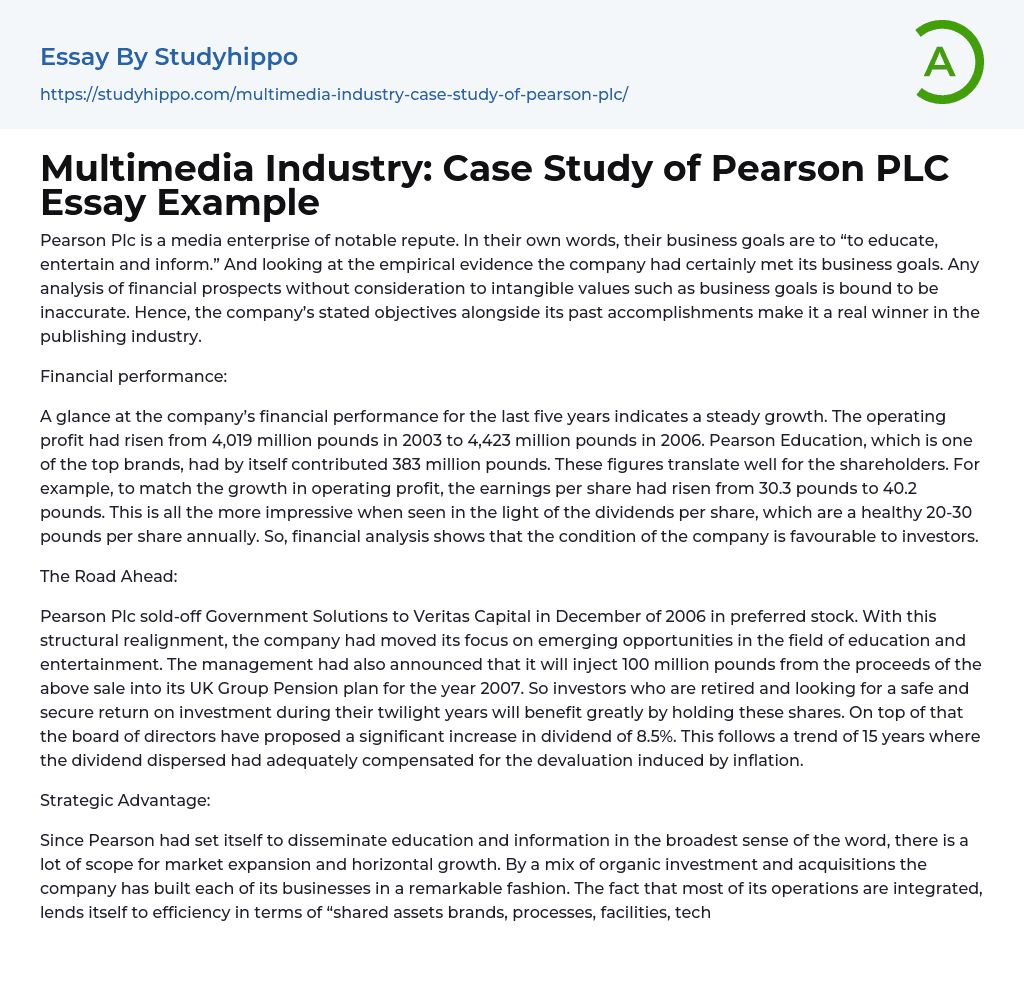

Multimedia Industry: Case Study of Pearson PLC Essay Example
Pearson Plc is a media enterprise of notable repute. In their own words, their business goals are to “to educate, entertain and inform.” And looking at the empirical evidence the company had certainly met its business goals. Any analysis of financial prospects without consideration to intangible values such as business goals is bound to be inaccurate. Hence, the company’s stated objectives alongside its past accomplishments make it a real winner in the publishing industry.
Financial performance:
A glance at the company’s financial performance for the last five years indicates a steady growth. The operating profit had risen from 4,019 million pounds in 2003 to 4,423 million pounds in 2006. Pearson Education, which is one of the top brands, had by itself contributed 383 million pounds. These figures translate well for the shareholde
...rs. For example, to match the growth in operating profit, the earnings per share had risen from 30.3 pounds to 40.2 pounds. This is all the more impressive when seen in the light of the dividends per share, which are a healthy 20-30 pounds per share annually. So, financial analysis shows that the condition of the company is favourable to investors.
The Road Ahead:
Pearson Plc sold-off Government Solutions to Veritas Capital in December of 2006 in preferred stock. With this structural realignment, the company had moved its focus on emerging opportunities in the field of education and entertainment. The management had also announced that it will inject 100 million pounds from the proceeds of the above sale into its UK Group Pension plan for the year 2007. So investors who are retired and looking for a safe and secure return on investment durin
their twilight years will benefit greatly by holding these shares. On top of that the board of directors have proposed a significant increase in dividend of 8.5%. This follows a trend of 15 years where the dividend dispersed had adequately compensated for the devaluation induced by inflation.
Strategic Advantage:
Since Pearson had set itself to disseminate education and information in the broadest sense of the word, there is a lot of scope for market expansion and horizontal growth. By a mix of organic investment and acquisitions the company has built each of its businesses in a remarkable fashion. The fact that most of its operations are integrated, lends itself to efficiency in terms of “shared assets brands, processes, facilities, technology and central services”. In addition to this, the company makes provisions for the fulfilment of its long term vision by investing in areas of content development, technology improvement, finding new market opportunities and overall efficiency.
The Management Team:
Pearson Plc. is led by proven experts in their respective fields. Glen Moreno is the Chairman, who brings with him his valuable experiences with Fidelity International and Man Group plc. Chief Executive Marjorie Scardino puts to good use her expertise in matters of law. Having had previous publishing experience from The Economist Group, she had transformed the company in the ten years since she took over this top position. In this respect, the executive team of Pearson is similar to that of EMI. Both these firms are headed by proven leaders with plenty of experience in the multimedia industry. So, all stakeholders in the company can rest assured that their investments are in safe and trustworthy hands.
References:
Bellotti, V. & Rogers, Y., 1997, From Web press to Web pressure: multimedia representations and multimedia publishing, Proceedings of the SIGCHI conference on Human factors in …, 1997 – portal.acm.org
Drew, M.S. & Li, Z.N., 2004, Fundamentals of Multimedia, School of Computer Science Publication, Canada, 2004
Multimedia Induatry, Annual reports from 2001–2006. [Online].
Available at:
Pearson Plc is a media enterprise of notable repute. In their own words, their business goals are to “to educate, entertain and inform.” And looking at the empirical evidence the company had certainly met its business goals. Any analysis of financial prospects without consideration to intangible values such as business goals is bound to be inaccurate. Hence, the company’s stated objectives alongside its past accomplishments make it a real winner in the publishing industry.
Financial performance:
A glance at the company’s financial performance for the last five years indicates a steady growth. The operating profit had risen from 4,019 million pounds in 2003 to 4,423 million pounds in 2006. Pearson Education, which is one of the top brands, had by itself contributed 383 million pounds. These figures translate well for the shareholders. For example, to match the growth in operating profit, the .
- Automotive essays
- Real Estate essays
- Construction essays
- E Commerce essays
- Commerce essays
- Polymers essays
- Automotive Industry essays
- Paper Industry essays
- Textile Industry essays
- Pharmaceutical industry essays
- Pharmacy essays
- Grocery stores essays
- Classical Mechanics essays
- Rail Transport essays
- Tata Motors essays
- Vehicle Brands essays
- trucks essays
- Auto Racing essays
- Harley-Davidson essays
- Suzuki essays
- Lexus essays
- Mercedes-Benz essays
- Buying Homes essays
- Futures Contract essays
- Mortgage Loan essays
- Renting essays
- Transaction Cost essays
- Building essays
- Optical Fiber essays
- Freezing essays
- Polymer essays
- Weaving essays
- Investing essays
- Asset essays
- Depreciation essays
- Discounted Cash Flow essays
- Foreign Direct Investment essays
- Funds essays
- Internal Rate Of Return essays
- Revenue essays
- Day Trading essays
- Futures Trading essays
- Capital market essays
- Million essays
- Payment essays
- Rate Of Return essays
- Funding essays
- Hedge Fund essays
- Board Of Directors essays
- Brand Management essays



